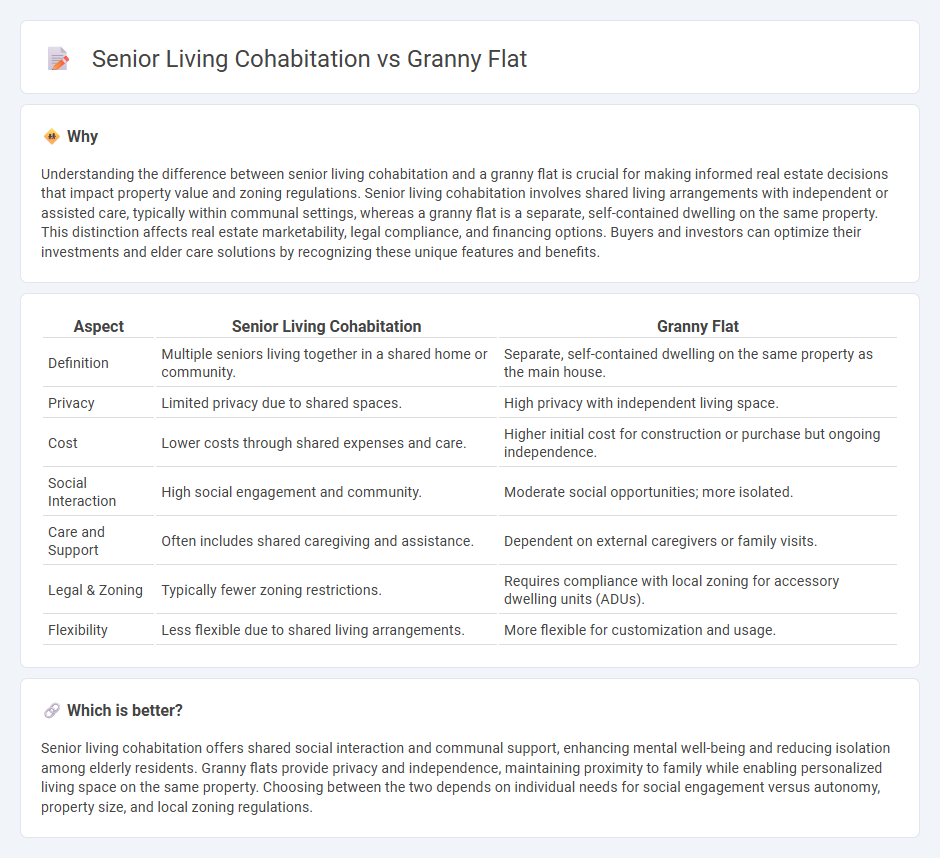
Senior living cohabitation offers shared housing environments designed to foster community and social interaction among older adults, often including communal spaces and support services. Granny flats, also known as accessory dwelling units (ADUs), provide independent, self-contained living spaces on the same property as the primary residence, allowing seniors privacy and proximity to family. Explore the advantages and considerations of each option to determine the best fit for your senior living needs.
Why it is important
Understanding the difference between senior living cohabitation and a granny flat is crucial for making informed real estate decisions that impact property value and zoning regulations. Senior living cohabitation involves shared living arrangements with independent or assisted care, typically within communal settings, whereas a granny flat is a separate, self-contained dwelling on the same property. This distinction affects real estate marketability, legal compliance, and financing options. Buyers and investors can optimize their investments and elder care solutions by recognizing these unique features and benefits.
Comparison Table
| Aspect | Senior Living Cohabitation | Granny Flat |
|---|---|---|
| Definition | Multiple seniors living together in a shared home or community. | Separate, self-contained dwelling on the same property as the main house. |
| Privacy | Limited privacy due to shared spaces. | High privacy with independent living space. |
| Cost | Lower costs through shared expenses and care. | Higher initial cost for construction or purchase but ongoing independence. |
| Social Interaction | High social engagement and community. | Moderate social opportunities; more isolated. |
| Care and Support | Often includes shared caregiving and assistance. | Dependent on external caregivers or family visits. |
| Legal & Zoning | Typically fewer zoning restrictions. | Requires compliance with local zoning for accessory dwelling units (ADUs). |
| Flexibility | Less flexible due to shared living arrangements. | More flexible for customization and usage. |
Which is better?
Senior living cohabitation offers shared social interaction and communal support, enhancing mental well-being and reducing isolation among elderly residents. Granny flats provide privacy and independence, maintaining proximity to family while enabling personalized living space on the same property. Choosing between the two depends on individual needs for social engagement versus autonomy, property size, and local zoning regulations.
Connection
Senior living cohabitation and granny flats are interconnected through their focus on multigenerational housing solutions that promote independence and family support. Granny flats offer a private, self-contained living space adjacent to the primary residence, enabling seniors to live close to family while maintaining autonomy. This setup enhances real estate value by catering to the growing demand for adaptable housing options that accommodate aging populations and foster social engagement.
Key Terms
Accessory Dwelling Unit (ADU)
Granny flats, also known as Accessory Dwelling Units (ADUs), offer seniors independent living spaces on family property, combining privacy with proximity to loved ones. Senior living cohabitation involves shared residences where seniors live communally, fostering social interaction but potentially limiting autonomy. Explore in-depth comparisons of ADUs and cohabitation to determine the best senior living solution for your needs.
Age-Restricted Housing
Age-restricted housing options, such as granny flats and senior living cohabitation, cater specifically to the needs of older adults, offering tailored environments that promote independence and community engagement. Granny flats provide a private, self-contained space within or adjacent to a family home, ensuring close familial support while maintaining personal autonomy, whereas senior living cohabitation typically involves shared residences with peers, fostering social interaction and access to assisted living amenities. Explore the benefits and suitability of each age-restricted housing choice to determine the best lifestyle fit for elderly individuals.
Independent Living
Granny flats offer a private, cost-effective housing solution that enables seniors to maintain independence while staying close to family support, and they typically feature accessible design tailored to aging needs. Senior living cohabitation communities provide a socially engaging environment with professional amenities and assistance, promoting independence through structured support and communal activities. Explore detailed comparisons to determine which independent living option best fits your lifestyle and care preferences.
Source and External Links
Everything You Need to Know About Granny Flats - This webpage provides comprehensive information on granny flats, including their usage, designs, and regulations in California.
Granny Flat Guide: Costs, Designs & Building Tips - This guide offers insights into the costs, designs, and building tips for granny flats, including various floor plans and space utilization strategies.
Granny Flat | Granny Unit | Prefab Guest House - This webpage discusses the versatility of granny flats, also known as ADUs, and offers customizable prefab solutions for different uses.
 dowidth.com
dowidth.com